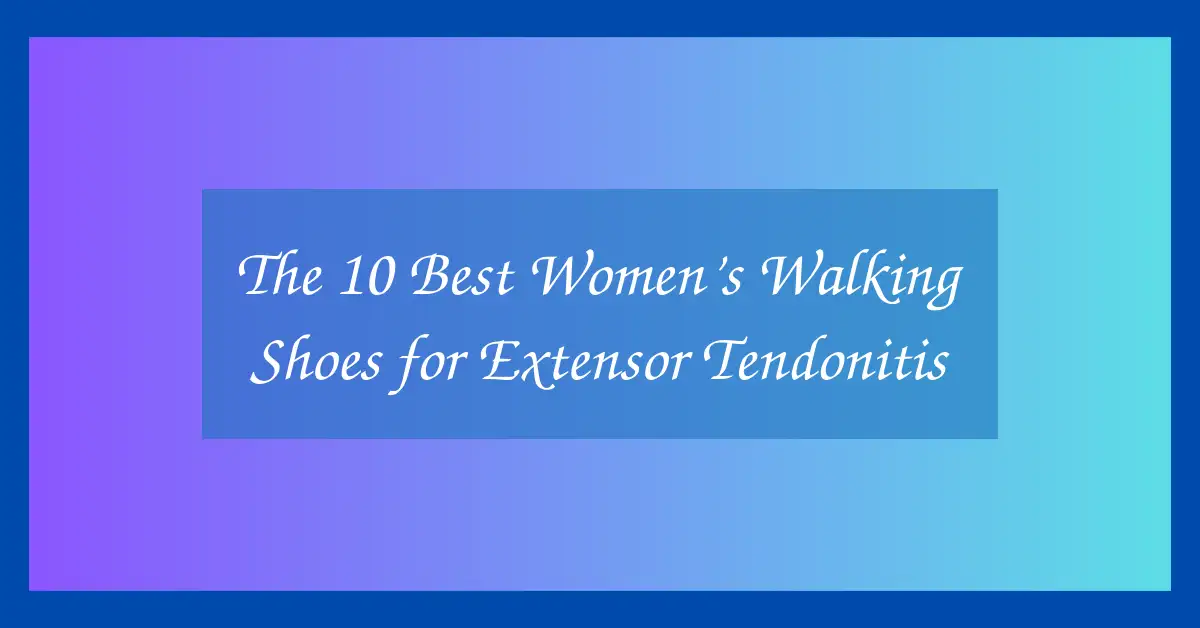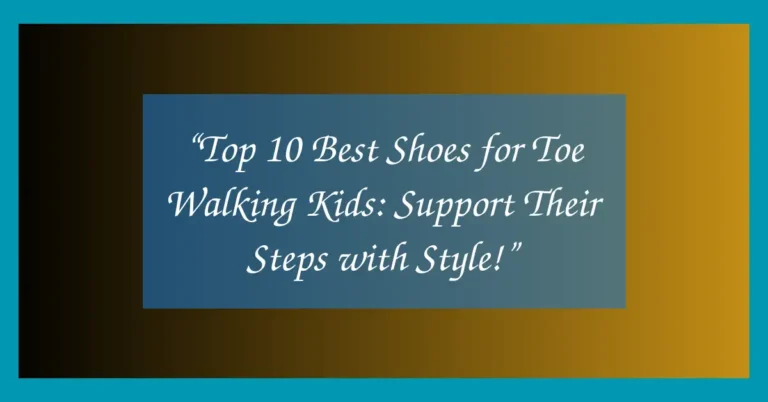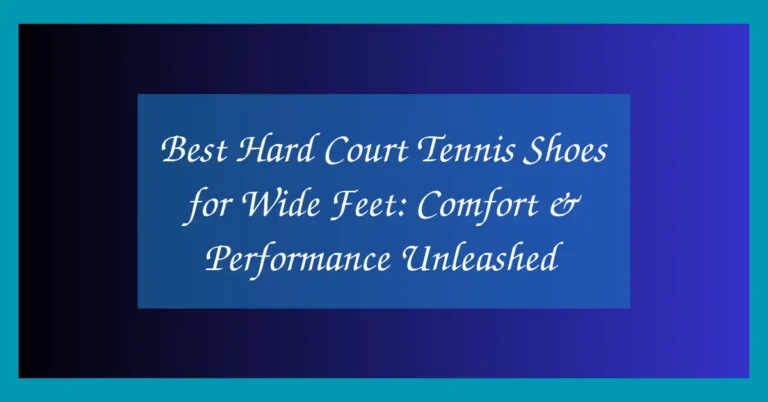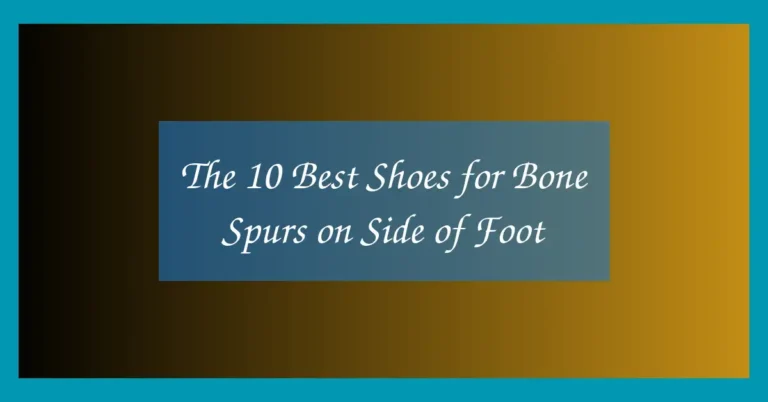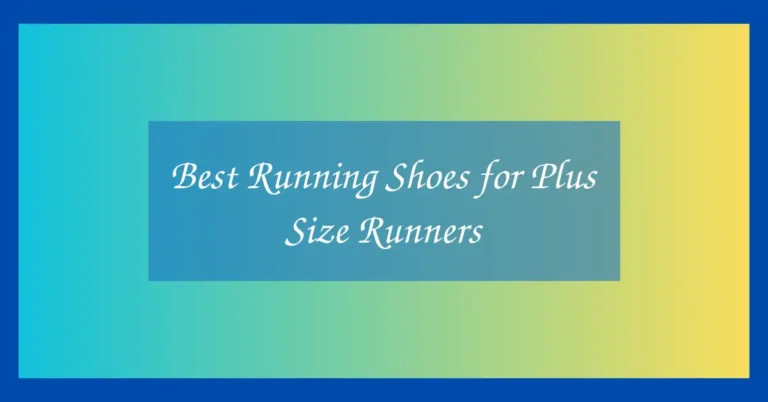The 10 Best Women’s Walking Shoes for Extensor Tendonitis
If you’re dealing with extensor tendonitis, the right footwear can make a huge difference. The best women’s walking shoes for extensor tendonitis are designed to reduce pressure on the top of the foot, provide superior cushioning, and maintain proper alignment during every step.
Our expertly curated list features walking shoes that combine comfort, support, and foot health. Each shoe listed here is selected based on its upper flexibility, arch support, toe box room, and ability to relieve strain on tendons. Let’s explore which options stand out for women managing extensor tendonitis.
Best Women’s Walking Shoes for Extensor Tendonitis
1. Brooks Addiction Walker 2
The Brooks Addiction Walker 2 is a stability walking shoe built with serious support. It comes with an Extended Progressive Diagonal Rollbar (PDRB) that supports your entire body and aligns your stride. This helps reduce pressure on the extensor tendons, easing pain while walking.
The full-grain leather upper offers structure while remaining flexible enough to avoid irritating the top of the foot. The BioMoGo DNA cushioning adapts to your stride, reducing impact with each step. It’s particularly effective for people who experience discomfort from flat feet or overpronation.
The shoe features a slip-resistant outsole that’s ideal for walking on different surfaces. It delivers steady traction and long-lasting durability. With a certified PDAC A5500 diabetic shoe rating, it’s designed to address both general and specific foot concerns.
It also provides roomy toe space which minimizes compression over sensitive areas. Whether you’re walking for exercise or everyday tasks, this pair offers all-day comfort for tendonitis sufferers.
Pros
- Supportive PDRB system for alignment
- Flexible full-grain leather upper
- Slip-resistant, durable outsole
Cons
- Leather can feel warm in hot climates
- Heavier than mesh-based models
2. New Balance 928v3
The New Balance 928v3 is built for stability and pain relief. Featuring motion control and ROLLBAR technology, it reduces rear-foot movement and stabilizes the gait cycle. This keeps extensor tendons from over-flexing and becoming strained.
The upper is made of breathable mesh combined with synthetic overlays, offering a balance of airflow and top-foot protection. The shoe provides superior arch support with its firm yet cushioned midsole, which absorbs shocks and reduces pressure buildup.
Its wide base and roomy forefoot allow natural toe splay, ensuring the top of the foot isn’t compressed. The Walking Strike Path on the outsole helps guide the foot through a natural stride. It’s also approved for medical conditions requiring orthopedic footwear.
This model is particularly recommended for women with overpronation, flat arches, or persistent tendon inflammation. It’s built to endure daily walking routines and long wear hours without compromising comfort.
Pros
- Stabilizing ROLLBAR for controlled gait
- Wide toe box reduces pressure on tendons
- Ideal for flat feet and overpronation
Cons
- Chunky profile not ideal for fashion
- Break-in period may be needed
3. HOKA ONE ONE Bondi 8
The HOKA ONE ONE Bondi 8 is known for its max cushioning and comfort. It’s an excellent choice for women with extensor tendonitis due to its thick EVA midsole and rocker bottom design. These features reduce upward pressure on the top of the foot.
The engineered mesh upper is soft and flexible, minimizing irritation across the laces and tendons. The Bondi 8 delivers smooth transitions from heel to toe, which helps reduce stress on sensitive foot structures during long walks.
Stability is enhanced through a widened base and a moderately structured heel counter. While not a motion control shoe, it offers enough support for neutral and mildly pronated feet. The insole is removable for custom orthotic use if needed.
Its deep cushioning makes it a standout for recovery walks, errands, or any scenario that demands long hours on your feet. Many users praise it for significant relief from top-foot pain and joint discomfort.
Pros
- Maximum EVA cushioning absorbs shock
- Soft mesh upper for foot comfort
- Rocker design eases toe-off motion
Cons
- Bulky silhouette
- Not ideal for narrow feet
4. Orthofeet Coral Stretch Knit
The Orthofeet Coral Stretch Knit is specially designed for women with foot pain, including extensor tendonitis. It features a stretchy knit upper that conforms to the foot shape without applying pressure on the top.
The anatomical arch support and cushioned ergonomic sole work together to promote foot alignment and reduce muscle fatigue. These factors relieve tension from overworked tendons and improve gait efficiency during walking.
It includes a premium orthotic insole with layers of foam and gel padding. This minimizes ground impact and redistributes pressure across the foot. The seam-free interior lining also helps prevent friction and irritation, especially for sensitive skin.
This shoe is lightweight and suitable for both casual wear and daily walks. Its built-in pain relief technology makes it a strong contender for women suffering from chronic foot discomfort.
Pros
- Stretchy upper relieves top-foot pressure
- Orthotic-friendly and removable insoles
- Excellent arch and heel cushioning
Cons
- Less stylish compared to athletic shoes
- Limited color variety
5. ASICS Gel-Nimbus 25
The ASICS Gel-Nimbus 25 is a cushioned running shoe that works well for walking too. It’s favored for its plush FF BLAST™ PLUS ECO midsole that delivers a soft yet responsive feel, easing impact on the top of the foot.
ASICS re-engineered the upper with an improved knit design, which eliminates stiff overlays across the laces. This new structure helps reduce irritation for those suffering from extensor tendonitis or top-foot sensitivity.
Rearfoot and forefoot GEL™ technology provide excellent shock absorption, while the OrthoLite™ X-55 sockliner adds extra step-in comfort. These cushioning elements reduce pressure on all foot contact points.
This model is a great fit for women seeking balance between cushioning and performance. It supports natural foot motion and reduces pressure over long distances, making it suitable for active lifestyles.
Pros
- Soft, eco-friendly cushioning
- Flexible upper reduces lace pressure
- Great for walking and light running
Cons
- Can feel too soft for those needing firm support
- High heel stack may not suit all
6. Saucony Integrity Walker 3
The Saucony Integrity Walker 3 is a walking-specific shoe with supportive features ideal for tendonitis relief. It uses a PWRRUN midsole for soft cushioning that absorbs impact and reduces foot fatigue over long distances.
The upper is made of durable full-grain leather but offers enough give around the laces to prevent pressure on the extensor tendons. Its plush tongue and padded collar further reduce irritation across the top of the foot.
This model has a non-marking slip-resistant outsole with a Walk Trac patented design for smoother transitions. The responsive sole and neutral support make it suitable for most foot types, especially those needing extra protection during walking.
Its consistent build, comfort-focused design, and high arch compatibility make it a solid everyday walking shoe for women dealing with top-foot discomfort and sensitive tendons.
Pros
- Soft PWRRUN cushioning for all-day comfort
- Supportive leather upper with padded collar
- Slip-resistant Walk Trac outsole
Cons
- Leather upper limits breathability
- Break-in period needed for some users
7. Ryka Devotion Plus 3
The Ryka Devotion Plus 3 is crafted specifically for a woman’s foot shape, with a narrower heel and roomier forefoot. This helps reduce friction and compression on the top of the foot, making it suitable for extensor tendonitis.
The shoe features RE-ZORB cushioning, which delivers shock absorption and responsive feedback. The lightweight mesh upper with supportive overlays reduces pressure from laces while maintaining structural support.
A molded EVA midsole and anatomical Precise-Return insole give arch and heel comfort during prolonged walking sessions. The outsole uses an eight-piece rubber pattern for traction and flexibility, aiding in smoother strides.
This model stands out for its blend of support, style, and female-specific engineering, offering a dependable option for everyday use, exercise, or recovery walking.
Pros
- Designed for women’s biomechanics
- RE-ZORB cushioning for impact protection
- Flexible mesh upper reduces lace pressure
Cons
- Less ideal for very flat feet
- Support may decrease with long-term wear
8. Altra Torin 7
The Altra Torin 7 stands out with its FootShape toe box and Balanced Cushioning platform. These design features keep the heel and forefoot level, which promotes natural foot positioning and reduces strain on the top-foot tendons.
It uses Altra EGO™ MAX midsole foam that provides soft yet lively cushioning. The engineered mesh upper is breathable and gentle on pressure points, making it a good fit for those with extensor tendon sensitivity.
The wide toe box allows for unrestricted toe movement, helping reduce compression over tendons. This makes it particularly beneficial for walkers with bunions or inflammation across the top of the foot.
Lightweight and smooth-rolling, this shoe is ideal for recovery walks, moderate exercise, or everyday movement with a focus on joint and tendon care.
Pros
- Zero-drop platform supports natural movement
- Spacious FootShape toe box
- Soft yet resilient EGO™ MAX cushioning
Cons
- Zero-drop feel not for everyone
- Not ideal for overpronators without inserts
9. OOFOS OOmg Low Shoe
The OOFOS OOmg Low Shoe is a recovery walking shoe with OOfoam™ technology that absorbs 37% more impact than traditional footwear. This reduces load on feet, joints, and especially sensitive tendons.
The 4-way stretch fabric upper adapts to foot contours and places minimal pressure on the top of the foot. It’s particularly helpful for women recovering from injury or managing chronic tendon discomfort.
The rocker sole helps reduce foot fatigue by assisting with forward momentum during walking. Although not a traditional athletic shoe, it offers therapeutic comfort for post-walk or all-day wear.
This option is best suited for low-impact use, around the house, errands, or light strolls when tendon pressure needs to be minimized as much as possible.
Pros
- OOfoam absorbs shock and reduces stress
- Flexible upper eliminates lace pressure
- Great for recovery or casual wear
Cons
- Not suitable for high-performance walking
- Limited lateral support
10. Skechers GOwalk Arch Fit
The Skechers GOwalk Arch Fit blends casual style with orthopedic support. Developed with podiatrist-certified arch support, it helps maintain alignment and reduces tension on the extensor tendons during walking.
The soft woven mesh upper includes stretch panels that adapt to the foot’s shape. This removes tight spots and prevents lacing from digging into sensitive areas of the top foot.
It uses a removable insole that molds to the foot while helping distribute pressure evenly. The lightweight ULTRA GO cushioning and high-rebound Comfort Pillar Technology™ offer smooth transitions and impact protection.
This shoe is ideal for women who want pain-free walking in a sporty yet supportive package. It’s suitable for long errands, travel, or low-impact fitness routines.
Pros
- Podiatrist-certified arch support
- Stretch mesh upper for pressure relief
- Soft, lightweight cushioning
Cons
- Support not firm enough for severe overpronators
- Less breathable in warm weather
| Product Name | Upper Material | Support Type | Cushioning | Toe Box |
|---|---|---|---|---|
| Brooks Addiction Walker 2 | Full-Grain Leather | Stability | BioMoGo DNA | Roomy |
| New Balance 928v3 | Mesh + Synthetic | Motion Control | Firm & Cushioned | Wide |
| HOKA ONE ONE Bondi 8 | Engineered Mesh | Neutral | Max EVA | Moderate |
| Orthofeet Coral | Stretch Knit | Orthopedic | Foam + Gel | Wide |
| ASICS Gel-Nimbus 25 | Soft Knit | Neutral | FF BLAST™ PLUS ECO | Standard |
| Saucony Integrity Walker 3 | Leather | Neutral | PWRRUN | Standard |
| Ryka Devotion Plus 3 | Mesh + Overlays | Neutral | RE-ZORB | Roomy Forefoot |
| Altra Torin 7 | Engineered Mesh | Zero Drop | EGO™ MAX | FootShape Wide |
| OOFOS OOmg Low | 4-Way Stretch | Recovery | OOfoam | Flexible |
| Skechers GOwalk Arch Fit | Stretch Mesh | Arch Support | ULTRA GO + Pillars | Moderate |
Best Women’s Walking Shoes for Extensor Tendonitis Buying Guide
1. Choose Flexible Uppers
Rigid uppers can press against the top of the foot and aggravate extensor tendons. Look for shoes with mesh, knit, or stretchable fabric uppers that reduce pressure and adjust to the foot’s shape naturally. Avoid thick overlays across the laces if you have tenderness on top of the foot.
2. Prioritize Arch and Heel Support
Good arch support reduces strain by distributing body weight evenly. Shoes with firm midfoot and heel structure promote proper alignment and lessen tendon overuse. This is especially important if you have flat feet or pronation-related pain.
3. Look for Cushioning That Absorbs Shock
Shock-absorbing midsoles such as EVA foam, gel, or proprietary blends reduce ground impact and protect sensitive tendons. Choose a shoe with responsive cushioning that matches your walking style and offers consistent support throughout the day.
4. Make Sure Toe Box Is Roomy
A wide or anatomically shaped toe box allows your toes to spread naturally and reduces upward pressure on the top of the foot. This space is crucial to avoid aggravating inflamed extensor tendons and other foot issues like bunions or swelling.
5. Avoid Overly Tight Lacing Systems
Laces and overlays that dig into the top of the foot can worsen tendonitis. Opt for models with padded tongues or customizable lacing patterns that reduce pressure zones. Some shoes also offer stretch panels or seamless uppers to improve comfort.
6. Stability and Motion Control Features
For those who overpronate or have uneven gait patterns, stability or motion control features can correct foot motion and relieve tendon stress. Consider shoes with roll bars, medial posts, or rocker soles for better walking efficiency.
FAQ
What is extensor tendonitis and how do walking shoes help?
Extensor tendonitis is inflammation of the tendons on the top of the foot, often caused by tight shoes or repetitive stress. Walking shoes with flexible uppers, cushioned midsoles, and a roomy toe box help relieve pressure, reduce irritation, and promote healing during movement.
Are running shoes suitable for walking with extensor tendonitis?
Yes, many cushioned running shoes can work well for walking. Models with soft uppers, good arch support, and shock-absorbing soles can help reduce tendon stress. Look for lightweight options with mesh uppers and a wide toe area.
Should I use orthotics for extensor tendonitis?
Orthotics can be beneficial if you need extra arch support or have alignment issues. Custom or over-the-counter orthotic inserts can help correct foot posture, redistribute pressure, and reduce strain on the extensor tendons during walking.
Can tight laces make extensor tendonitis worse?
Yes, overly tight laces increase pressure on the top of the foot and can irritate the extensor tendons. Choose shoes with padded tongues or soft uppers, and consider alternate lacing techniques to reduce top-foot pressure while keeping the shoe secure.
Are leather walking shoes good for extensor tendonitis?
Leather shoes can provide support and durability, but they must be flexible enough to avoid putting pressure on the tendons. Look for leather shoes with padded tongues and minimal seam structure to ensure comfort across the top of the foot.
How can I prevent extensor tendonitis from returning?
To prevent recurrence, wear supportive and properly fitted shoes, avoid tight lacing, stretch your feet regularly, and rest when pain flares. Gradually increase walking distance and always choose footwear designed to minimize pressure on the top of the foot.
Verdict
Choosing the best women’s walking shoes for extensor tendonitis can significantly improve comfort, reduce foot strain, and support long-term recovery. The right pair will have a soft, flexible upper, adequate cushioning, arch support, and a roomy toe box. Whether you’re walking for exercise or daily errands, prioritizing foot health can help you move with less pain and more confidence.

